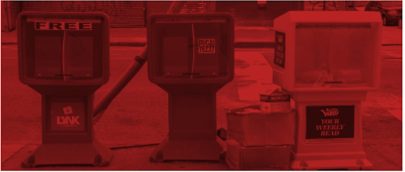Broadband Expansion
How local news organizations can help their communities advance digital equity – and obtain financial support for civic journalism
The Opportunity
The federal government is allocating billions of dollars to states to expand broadband access, affordability and “digital equity” via the Digital Equity Act and Broadband Access, Equity and Deployment programs. States were required to submit plans showing how they will use the funds to pursue digital equity, which is when citizens have all the resources, skills and information needed to be full participants in their economies, democracies and societies. These plans outline how states will allocate funds to community institutions, or “trusted community partners” in digital equity parlance, to promote different elements of digital equity.
States were required to submit their broadband and digital equity plans by Oct. 30, after which stakeholders will have 30 days to submit feedback on the plans. Plans will be posted on a state’s broadband authority’s website. Broadband authorities vary – at times its an office within a state’s commerce department, other times it’s an independent body – but newsrooms can use National Telecoms and Information Administration’s interactive map to learn more about who governs broadband and digital equity programs in their state, which will help them know where to look for local digital equity plans. Now is the time to read your state’s plan and tell your state’s digital equity authorities that newsrooms can help bridge the digital divide – and should be eligible for grant money to help do so.
What does this have to do with local news?
Providing access to high speed internet is an essential piece of pursuing universal internet access and digital equity, but more connectivity alone won’t achieve the broader goals. States will need to initiate other projects to ensure that residents can participate fully in civic life – and local news organizations can play a crucial role. For example, about half of news deserts are “double deserts” – meaning they lack both broadband and local news. Building out broadband infrastructure without shoring up local news could, as one expert put it, just provide “high speed access to garbage.” In any areas with little to no trustworthy local news, newly connected residents would still not be able to have equal capacity to shape and benefit from their communities.
Other important community organizations like schools, libraries, and public housing complexes are offering themselves as “trusted community partners” – a status that makes them eligible for grants through the Digital Equity Act – or “anchor institutions” – the status required to be eligible for grants in the case of the Broadband Equity Access and Deployment program (BEAD). Newsrooms should do the same.
When newsrooms, or journalism organizations, submit their proposals to state officials, they should consider highlighting:
- Local newsrooms are trusted community partners. Those who regularly follow local news are more attached to their community, vote more regularly, and actively participate in local groups and political activity more frequently.
- Local news reaches populations the Digital Equity Act hopes to reach, including minority communities, those who speak languages other than English, the incarcerated and formerly incarcerated, those who are older and those living in rural communities.
- As governments and advertisers seek to get critical information to communities, they face unprecedented fraud and misinformation in online social networks and platforms. Local news is a reliable and effective way to inform people about resources in their communities, like new or upgraded broadband services.
- Residents consistently report seeking news as one of the top uses for the internet in broadband plans.
Right now news organizations should:
- Read their state’s digital equity plans and identify elements of the plan their newsroom could build on. Can you scale up a current program, hire staff to facilitate it or extend it into new areas? Consider how what you are already doing might be reframed, better defined or more targeted to qualify for grant funding.
- Consider what your newsroom could do to help your community get more online and more engaged in civic life. Schools and libraries would be a natural partner with newsrooms on some elements of digital equity. But partnership don’t need to be limited to those institutions. Think creatively about how to bring your organization’s skills and resources to your community in ways that also meet the goals of digital equity.
- Assess your own organization’s digital needs and consider opportunities to seek grant funding for new services. What could your newsroom do with higher speed internet? Could you create more multimedia content, add reporting capacity, become a wireless hub for your community? Could you buy new hardware and software to create news content, to better track reader analytics or to add services for advertisers?
Newsrooms could propose using funding to:
Strengthen the availability of reporting and information in news deserts.
One-time digital equity capacity grants could fund the hiring of additional journalists to expand a newsroom’s coverage area and initiatives that strengthen basic local reporting. Or it could launch civic programs that teach local residents reporting and digital skills (i.e. Documenters, Earn Your Press Pass, Folk Reporters, etc.)
A news organization employs professionals and directs substantial resources to cover elections, schools, hospitals, transportation, emergency response, land use and development, public safety and criminal justice.
Studies have shown that when local news contracts, it leads to less participation in civic institutions such as PTAs and lower voter turnout. Conversely, adding information about those crucial topics can make it more possible for residents to be involved in their children’s schools, make informed decisions about elections, express opinions about community planning, environmental hazards and countless other topics. Empowered residents are, in turn, more likely to get better services from municipal governments and participate civically, a key component of digital equity.
Become an “anchor institution” or a “community partner” to help residents better use high speed internet
Anchor institutions – under the Broadband, Equity, Access and Deployment (BEAD) broadband program – are designated community organizations that help citizens use and access the internet. Anchor institutions can offer broadband to the public, like a library or a school, or can also help residents use the internet. For instance, a public broadcaster told Rebuild Local News it helps residents get email addresses – that program would likely qualify that newsroom as an anchor institution. A news outlet could also provide digital literacy training. Anchor institutions also get gigabit broadband service through state BEAD programs, meaning newsrooms could increase their own broadband availability while increasing access to the wider community.
To become an anchor institution, a newsroom would need to make the case that it, in NTIA’s parlance, “facilitates greater use of broadband service by vulnerable populations including, but not limited to, low-income individuals, unemployed individuals, children, the incarcerated, and aged individuals.”
A local newsroom could also be designated a trusted community partner to help administer digital literacy training, including media literacy, to community members. States are mandated to bridge the digital divide between online and unconnected communities by teaching digital skills and literacy and teaching residents how to trouble-shoot typical broadband access issues via programs called digital navigators. Digital navigators assist people one-on-one or in small groups, to get affordable home internet service, affordable internet-capable devices, and/or coach them in basic digital skills. They can assist people in person, over the phone, by email, text, video chat, and other methods, depending on a person’s needs. A newsroom designated a “trusted community partner” or “anchor institution” could partner with other community institutions such as public libraries or schools to provide navigation services.
For example, The North Carolina Community College System deployed trained digital navigators at 20 community colleges that serve every county in the state; they created a Spanish and English version of a Digital Navigator Certificate, and recruited adults from communities most impacted by the digital divide to serve as digital navigators. Digital Navigator programs have important economic and educational benefits, but with the guidance of newsrooms, can have critical civic engagement impacts, as well. It’s not hard to imagine a local newspaper, state-wide news organization or public broadcaster collaborating with a local institution to add modules on vetting information, media literacy and spotting disinformation.
Upgrade your technology
Newsrooms could request funds to upgrade hardware and software that maximizes news content and reporting power, as well as digital speed and capacity. There are two paths for these types of investments. First, if a newsroom was designated an anchor institution under the Broadband Equity, Access and Deployment program, they would be eligible to get gigabit broadband service via state broadband investments. News outlets could also benefit from a digital equity program that makes newsrooms or organizations that service newsrooms, like press associations or academic institutions, eligible for grants to either improve a newsroom’s broadband services or increase digital skills within the newsroom.
Serve as an advertising venue
Internet Service Providers (ISPs) are required to notify communities through advertising about changes to service as broadband expands. Local newsrooms are essential for spreading the word. Be aware of projects happening in your community and the companies administering those projects. Most states have a contract database that shows which providers are working in which counties. Propose that they advertise in local newsrooms.
Find more and better ways to connect to your community, to build trust and engagement.
In some cases, making the most of Digital Equity funding will mean thinking about the role of a local news organization in a new way. Local news is already trusted, already engaged in informing and connecting communities, already helping audiences find the best information and online resources. News organizations now need to promote those aspects of their work and build upon them
Examples to consider:
- An organization in Kentucky suggested state digital equity dollars go toward a “digital counselor” for newsrooms to upgrade their digital skills and strategy as they acquire better broadband access.
- The North Carolina News Workshop partnered with Elon University to create a news hub to reach small communities with statehouse news that impacts them. The News Hub embedded journalists and interns around the state to localize state-level issues with the help of community partners. They added “documenters” to attend local meetings, collaborated to produce resource guides, hosted community meetings to amplify local issues, and collaborated with newsrooms around the state on larger local reporting projects that were free to publish everywhere.
- A local newsroom could partner with a local library to teach media literacy and other digital skills to community members.
- The most ambitious use of digital equity dollars would be to fund local newsrooms to expand their coverage into double deserts, or even help launch a new local news outlet in a double desert. For more ideas read Rebuild Local News digital equity proposal.
What local news organizations need to do now…
Read your state’s broadband and digital equity plans. They can be found on your state’s website for its broadband authority or the commerce department, which oversees broadband and digital equity efforts in most states. As you read, think about how your news organization or the news organizations in your state could – and maybe already does – provide the kinds of services NTIA wants to fund: those that bring vulnerable populations into full civic and community participation.
The first grants to seek are sub-grants through your state; a competitive nationwide grant program will open up later, but the competition will be greater for these funds.
Local news leaders should reach out to their state’s digital equity and broadband planning boards, which can be found at Broadband USA or the Benton Institute.
LETTER TEMPLATE:
To the [TK name of broadband authority i.e. Kansas Office of Broadband Development, Arizona Commerce Department, etc.],
We write to you as [explain who you are, and what you do]
We applaud your detailed and ambitious efforts to bring universal broadband and digital equity to [TK state]. However, we encourage the [TK name of broadband authority] to consider the role news organizations play in advancing digital literacy, adoption and broadband access programs.
First, newsrooms can play a direct role in helping train residents on the uses of the internet. Newsrooms are in an ideal position to provide or contribute to programs for digital navigators or otherwise help residents learn digital literacy. [Examples of how newsrooms have in the past or could in the future play this role – For example, the Wichita Community Foundation is launching a documenters program; A Kansas newspaper has an online program that teaching reporting and digital skills to residents; A public broadcaster told Rebuild Local News that it helps community members access email addresses.] To build on these programs, [TK state broadband authority] should designate newsrooms and organizations that support newsrooms as “trusted community partners” and/or anchor institutions under the Digital Equity or BEAD programs.
[If your state’s Broadband Equity, Access and Deployment plan requires broadband service providers to include advertising plans with their applications for state grants you could consider including:
Second, we encourage the state to use local news organizations to advertise services that are being provided as broadband access and affordability are expanded. Broadband Equity, Access and Deployment sub-grantees should be required to prioritize advertising in local media to alert residents of new services or programs in their area, such as public broadcast stations, nonprofit newsrooms, local print newspapers or hyperlocal websites. National research shows local news is the most trusted source for news across all age groups. In vetting the marketing plans of BEAD sub-grantees, state authorities should prioritize advertising plans that include local news placements, thereby leveraging the trust local communities have in their local news outlets.]
Third [Or Second if the above graph is omitted], digital equity plans should strengthen local news outlets in order to provide trustworthy information as the state increases broadband access and use in communities. Digital equity aspires to equip residents with the resources, infrastructure and skills to be full participants in their democracies, economies and societies, which is impossible to achieve without strong local news. A robust body of research of the last two decades has shown that areas that lack local news have lower voting turnout, less competitive elections, fewer residents are likely to know the name of their representatives or even google the mayor. But it doesn’t stop there. A West Virginia University study of successful West Virginia newsrooms showed “there is an undeniable correlation between a strong local news product and a persevering local business dynamic.” One expert even told Rebuild Local News that building out broadband access without also shoring up local news is like providing “high speed access to garbage” because national news, partisan information or outright falsehoods usually fill the vacuum left by weak or nonexistent local news outlets.
As a starting point, [TK state broadband authority] could help local news outlets, particularly those in rural areas, upgrade their technology to better serve their communities. [If your state’s Broadband Equity, Access and Deployment plan OR your state’s Digital Equity plan describe the effects of poor broadband service on small businesses, highlight that portion and point out that many local newsrooms are themselves small businesses or nonprofits.] The state could, for instance, provide grants to news organizations to upgrade websites. Such a program would not only support digital equity by creating more revenue opportunities for newsrooms via digital advertising, subscriptions and memberships, but the wider community. It would ensure that local news would be waiting for residents as they access greater broadband services, helping those residents to get the information they need and more fully participate in civic life.
Finally, states should consider strengthening the ability of news outlets to provide trustworthy information in under-served areas. Some areas may lack local news entirely – areas called news deserts – or may no longer have a local news outlet that provides adequate coverage of important local matters. In [TK state] news deserts include [TK news desert counties in your state]. Areas that lack both broadband and adequate local news are “double deserts” (in the parlance of the Rebuild Local News coalition). In double deserts, [TK state] should consider supporting programs that fund news organizations to improve local coverage. That could mean a local entity expanding coverage into a neighboring community or a statewide news outlet creating a new reporting project there. This would help improve civic participation.
We thank you for your dedication to broadband equity and access, as well as ensuring that all [TK shorthand for residents from your state – i.e. Kansans, Missourians, Texans, etc.] have the ability to be full digital participants.
Thank you for your consideration,
[TK signature]




